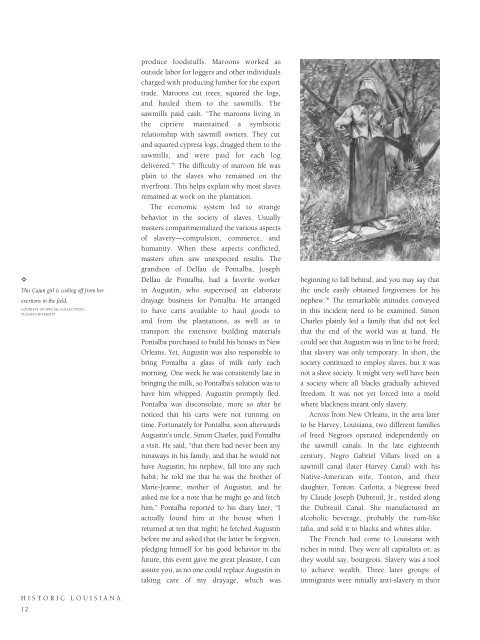Historic Louisiana
An illustrated history of Louisiana, paired with the histories of companies, families and organizations that make the state great.
An illustrated history of Louisiana, paired with the histories of companies, families and organizations that make the state great.
You also want an ePaper? Increase the reach of your titles
YUMPU automatically turns print PDFs into web optimized ePapers that Google loves.
✧<br />
This Cajun girl is cooling off from her<br />
exertions in the field.<br />
COURTESY OF SPECIAL COLLECTIONS,<br />
TULANE UNIVERSITY.<br />
HISTORIC LOUISIANA<br />
12<br />
produce foodstuffs. Maroons worked as<br />
outside labor for loggers and other individuals<br />
charged with producing lumber for the export<br />
trade. Maroons cut trees, squared the logs,<br />
and hauled them to the sawmills. The<br />
sawmills paid cash. “The maroons living in<br />
the ciprière maintained a symbiotic<br />
relationship with sawmill owners. They cut<br />
and squared cypress logs, dragged them to the<br />
sawmills, and were paid for each log<br />
delivered.” 7 The difficulty of maroon life was<br />
plain to the slaves who remained on the<br />
riverfront. This helps explain why most slaves<br />
remained at work on the plantation.<br />
The economic system led to strange<br />
behavior in the society of slaves. Usually<br />
masters compartmentalized the various aspects<br />
of slavery—compulsion, commerce, and<br />
humanity. When these aspects conflicted,<br />
masters often saw unexpected results. The<br />
grandson of Delfau de Pontalba, Joseph<br />
Delfau de Pontalba, had a favorite worker<br />
in Augustin, who supervised an elaborate<br />
drayage business for Pontalba. He arranged<br />
to have carts available to haul goods to<br />
and from the plantations, as well as to<br />
transport the extensive building materials<br />
Pontalba purchased to build his houses in New<br />
Orleans. Yet, Augustin was also responsible to<br />
bring Pontalba a glass of milk early each<br />
morning. One week he was consistently late in<br />
bringing the milk, so Pontalba’s solution was to<br />
have him whipped. Augustin promptly fled.<br />
Pontalba was disconsolate, more so after he<br />
noticed that his carts were not running on<br />
time. Fortunately for Pontalba, soon afterwards<br />
Augustin’s uncle, Simon Charles, paid Pontalba<br />
a visit. He said, “that there had never been any<br />
runaways in his family, and that he would not<br />
have Augustin, his nephew, fall into any such<br />
habit; he told me that he was the brother of<br />
Marie-Jeanne, mother of Augustin, and he<br />
asked me for a note that he might go and fetch<br />
him.” Pontalba reported to his diary later, “I<br />
actually found him at the house when I<br />
returned at ten that night; he fetched Augustin<br />
before me and asked that the latter be forgiven,<br />
pledging himself for his good behavior in the<br />
future, this event gave me great pleasure, I can<br />
assure you, as no one could replace Augustin in<br />
taking care of my drayage, which was<br />
beginning to fall behind, and you may say that<br />
the uncle easily obtained forgiveness for his<br />
nephew.” 8 The remarkable attitudes conveyed<br />
in this incident need to be examined. Simon<br />
Charles plainly led a family that did not feel<br />
that the end of the world was at hand. He<br />
could see that Augustin was in line to be freed;<br />
that slavery was only temporary. In short, the<br />
society continued to employ slaves, but it was<br />
not a slave society. It might very well have been<br />
a society where all blacks gradually achieved<br />
freedom. It was not yet forced into a mold<br />
where blackness meant only slavery.<br />
Across from New Orleans, in the area later<br />
to be Harvey, <strong>Louisiana</strong>, two different families<br />
of freed Negroes operated independently on<br />
the sawmill canals. In the late eighteenth<br />
century, Negro Gabriel Villars lived on a<br />
sawmill canal (later Harvey Canal) with his<br />
Native-American wife, Tonton, and their<br />
daughter, Tonton. Carlotta, a Negresse freed<br />
by Claude Joseph Dubreuil, Jr., resided along<br />
the Dubreuil Canal. She manufactured an<br />
alcoholic beverage, probably the rum-like<br />
tafia, and sold it to blacks and whites alike.<br />
The French had come to <strong>Louisiana</strong> with<br />
riches in mind. They were all capitalists or, as<br />
they would say, bourgeois. Slavery was a tool<br />
to achieve wealth. Three later groups of<br />
immigrants were initially anti-slavery in their
















